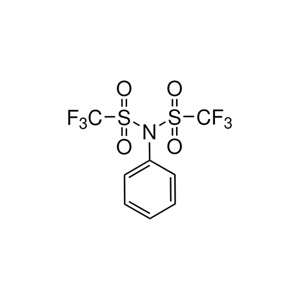Explore Top-Quality N-Phenyltriflimide (PhNTf2, CAS 37595-74-7) with Aure Chemical
Aure Chemical is a premier global supplier of high-quality N-Phenyltriflimide, commonly abbreviated as PhNTf2. Identified by its CAS number 37595-74-7, N-Phenyltriflimide is a white to off-white crystalline solid highly regarded in organic chemistry for its unique properties as a non-nucleophilic triflating agent and a versatile Lewis acid. Unlike other triflating agents, PhNTf2 offers a milder and more selective approach to introduce the triflate group, minimizing unwanted side reactions. It is an indispensable reagent for creating highly reactive intermediates such as vinyl triflates and enol triflates, crucial for carbon-carbon bond formation reactions. Its applications are vital in the synthesis of complex pharmaceuticals, agrochemicals, natural products, and advanced materials. Aure Chemical is committed to providing N-Phenyltriflimide that meets stringent purity and performance requirements, ensuring consistent and reliable results for your most demanding industrial and research applications. Partner with us for a dependable supply of this critical chemical.
Basic Information of N-Phenyltriflimide
N-Phenyltriflimide (PhNTf2, CAS No. 37595-74-7) is meticulously produced and rigorously tested to meet stringent quality standards. We offer various grades to suit your specific application requirements:
| CAS No.: | 37595-74-7 |
|---|
| EC No.: | 609-445-0 |
|---|
| Linear Formula: | PhN(SO₂CF₃)₂ |
|---|
| Molecular Weight: | 357.25 |
|---|
| Appearance: | White to off-white crystalline solid. |
|---|
| Melting Point: | 100-102 °C(lit.) |
|---|
| Boiling point: | 305.3±52.0 °C(Predicted) |
|---|
| Density: | 1.766±0.06 g/cm3(Predicted) |
|---|
| Solubility: | Soluble in many common organic solvents (e.g., dichloromethane, THF, toluene, acetonitrile). |
|---|
| Stability: | Relatively stable under anhydrous conditions. |
|---|
| Purity: | Available in high purity grades (e.g., 98% min) for sensitive synthetic applications. |
|---|
| Chemical Structure: |  |
|---|
Our commitment to delivering high-purity N-Phenyltriflimide ensures a reliable and efficient component for your critical processes, offering consistent quality for diverse synthetic and industrial applications.
Primary Applications of N-Phenyltriflimide (PhNTf2)
N-Phenyltriflimide's unique properties as a non-nucleophilic triflating agent and mild Lewis acid make it an invaluable reagent with significant applications in various advanced chemical processes:
Triflating Agent / Derivatizing Agent:
PhNTf2 is widely used for introducing the trifluoromethanesulfonyl (triflyl) group ($CF_3SO_2-$) into organic molecules. Its key applications include:
Synthesis of Enol Triflates: Reacts with ketones and aldehydes (often in the presence of a non-nucleophilic base) to form enol triflates, which are highly reactive intermediates for cross-coupling reactions (e.g., Suzuki, Heck) and other C-C bond formations.
Synthesis of Vinyl Triflates: Similarly used to prepare vinyl triflates from enones, useful in palladium-catalyzed couplings.
Activation of Hydroxyl Groups: Converts alcohols into triflates, making them excellent leaving groups for substitution, elimination, and rearrangement reactions, often with high stereoselectivity.
Lewis Acid Catalyst:
It can function as a mild Lewis acid catalyst in various organic reactions where stronger Lewis acids might lead to undesirable side reactions or decomposition. This includes certain types of condensations, additions, and rearrangements.
Non-Nucleophilic Base / Proton Scavenger:
Although primarily a triflating agent, the imide anion formed after triflation is a very weak nucleophile. In some contexts, it can act as a non-nucleophilic base or proton scavenger, particularly when paired with a strong acid.
Pharmaceutical and Agrochemical Synthesis:
PhNTf2 is a crucial reagent in the synthesis of complex active pharmaceutical ingredients (APIs) and agrochemicals, enabling precise and selective functionalization of molecules, which is vital for drug discovery and development.
Natural Product Synthesis:
Its ability to facilitate stereoselective reactions and generate reactive intermediates makes it highly valuable in the total synthesis of intricate natural products.
Why Choose Aure Chemical for Your N-Phenyltriflimide (PhNTf2) Supply?
Aure Chemical is dedicated to providing superior chemical solutions and unparalleled customer support. By partnering with us for your N-Phenyltriflimide requirements, you benefit from:
Exceptional Purity & Consistent Quality: Our N-Phenyltriflimide is manufactured to stringent purity specifications, crucial for achieving optimal and reproducible results in sensitive organic syntheses and demanding industrial processes.
Reliable Global Supply Chain: We maintain a robust and efficient global supply network, guaranteeing timely and secure delivery of this essential, reactive chemical to your facilities worldwide, with specialized packaging and handling expertise.
Expert Technical Support: Our dedicated team of specialists is readily available to offer comprehensive guidance on product application, safe handling procedures, optimal storage, and usage in your specific chemical processes, ensuring maximum safety and efficiency.
Commitment to Quality & Responsible Stewardship: We adhere to the highest industry standards for quality management, environmental responsibility, and product stewardship across all our operations, ensuring peace of mind for our clients and sustainable sourcing practices.
Customized Solutions: We understand that different applications may require specific purity levels or formulations. We are open to discussing customized solutions to meet your exact requirements.
Choose Aure Chemical for a trustworthy and dependable supply of high-quality N-Phenyltriflimide (PhNTf2). We're ready to empower your most advanced chemical synthesis and research endeavors with an unwavering commitment to quality and excellence.

